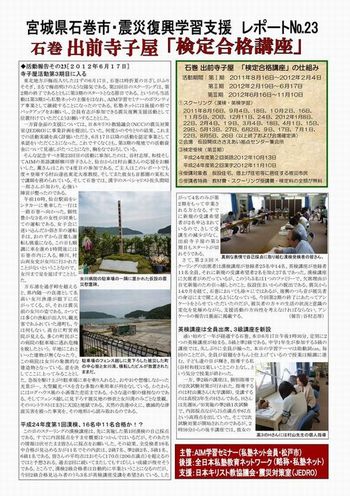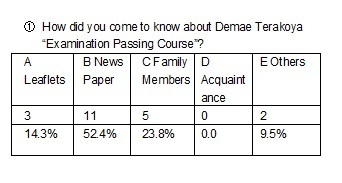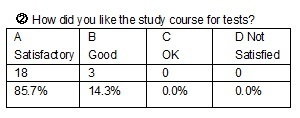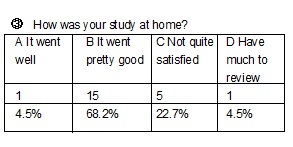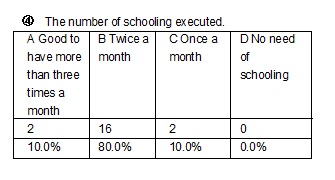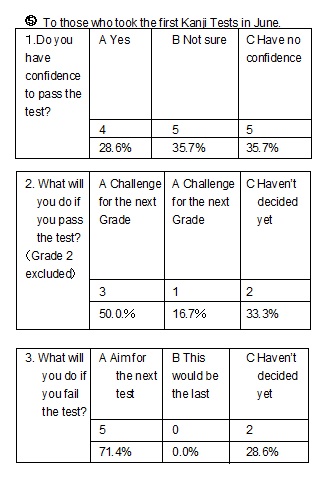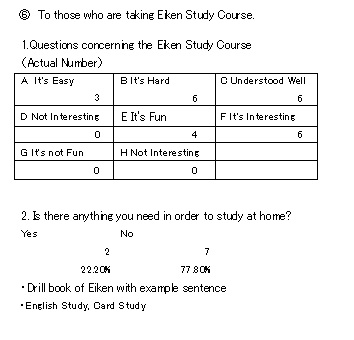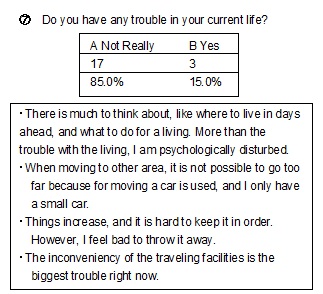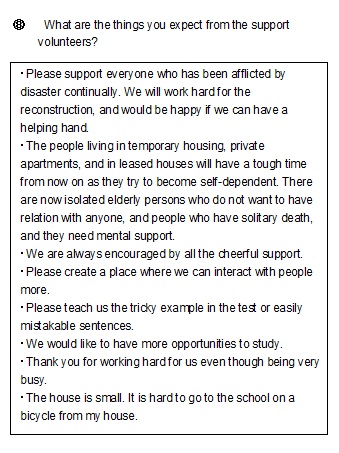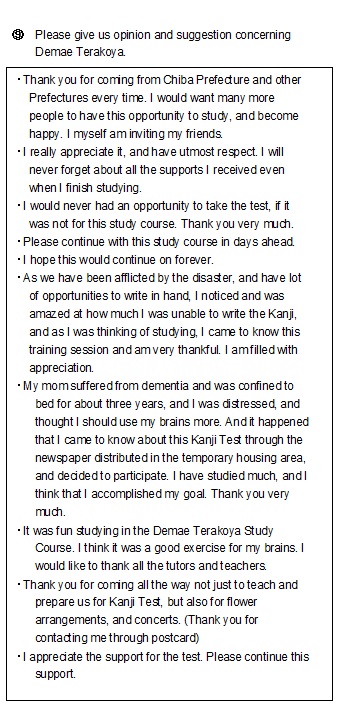Report of “Demae Terakoya” Ishinomaki
Tohoku HELP, wishing to take on a role as a support center for disaster afflicted areas, cooperates with over hundred denominations, thus continuing its activity. The condition of disaster afflicted area changes every moment. People who actually support in the front lines are the ones who sense the change most.
By supporting them, and learning from them, we would like to start our new step.
We are sending the following report which had been sent to us at the end of last month.
The data informs the current situation of Ishinomaki.
The report for support written here is a support called “Regain the joy of living”. We would like to remember the support work of theirs together with all of you.
(July 17th 2012 Written by Naoya Kawakami)
********************************************************
◆Session Report No.23 (June 17th 2012)
Activity of Terakoya starts its third semester.
Today June 17th, when the rainy season of Tohoku area is said to have started, hot summer sunshine is glaring occasionally, as if the rainy season has already passed. The 23rd class since the starting, which is the end of second semester, is also the start of the third semester.
It is also a new turning point, because it has been decided that this activity, from the third semester will become independent from the sponsoring of Shijuku Net, and will continue its activity as a volunteer project of AIM Learning Seminar. Shijuku Net has been asked to simply backup from now on, so that this activity would have its position as the Earthquake Disaster Reconstruction Support Activity in which volunteer members could participate.
As for the financial support, project plan has been submitted to Earthquake Disaster Countermeasure Compartment (JEDRO) of Nippon Christian Council(NCC).
After corresponding for a few times, we have received a high valuation on our activity achievements which we have been performing till now, and received approval as Certified Business Operator for the activity from June 17th onwards.
It means that through this result, the fund for the third semester has become visible at the least, which has greatly relieved us.
On this commemorable 23rd activity, participated Shiko Tanimura, Kazue, and an English teacher of AIM Keiko Yanagawa.
Also Kaoru Murayama from Sendai was called to lend a helping hand. This is Kaoru Murayama’s fourth time participating in this teaching activity. Her husband Tatsuya Murayama is an associate professor in Tohoku University, who often appears in this report.
And Kaoru Murayama herself works as a teacher in a certain private university in the Metropolitan area.
In Ishinomaki, Shoichiro Sakuma who is a specialist in Kanji also joined, and in this way heartening administrators was arranged.
The party got in to the rented car from Sendai station at 10 A.M., and headed for Ishinomaki.
Three ladies of strong characters were in a single car, which made the driver very careful both to choose the word when speaking, and also of driving.
This driver seemed like a lost sheep which had wandered in the girls-gathering.
The car moved on with a wonderful pace this day, and we reached Ishinomaki in an hour. Since Ms. Yanagawa, and Murayama said that they had never been in Onagawa, everyone agreed on making a side trip.
After passing through Mangokuura, and the ridge crossed, the best port in the whole prefecture called Onagawa Fishing Port came into view which stretched out below. No, we should say, the best port used to come in view which stretched out below.
Because though Onagawa Fishing Port once was a port town where many finishing boat came in and went out frequently, and were filled with tourist, now there is nothing left there.
The flourishing port town is now but a memory. A town-managed hospital could be seen on top of a hill.
Many townspeople took refuge in this hospitals parking lot, and evaded disaster. Now that there are no specific buildings in the plains, this hospital is the only symbolic building standing now in Onagawa. With grim determination we climbed the hill.
After driving up the steep hill and into the parking lot, the scenery which we did not expect came in our view.
Motorcoach for tour and several passenger vehicles had been lined up. And beside it there was even a stylish store, designed like a log house.
It had an aspect of a small roadside station. And overlooking the fence stretched out the dreadful disaster afflicted area, and a beautiful landscape of Onagawa Port.
It’s contrast was certainly like heaven and hell. Since the place is a natural fine harbor, undeniable destruction by tsunami disaster could be seen from the lie of the land.
The first test of kanji skills in Year 2012. Did eleven out of sixteen students pass the exams?
The schooling for this day’s kanji test course was marking one’s own kanji test which they took previously.
Test sheet had been internally graded, and the general idea of who had passed the exam was known, but by concealing the information, the students were told to mark their test. In the result, there were 11 examinee out of 16, who’s success could be expected.
Those who’s success could be expected was 7 examinee from the students who took the Second Grade test, 2 examinee for Grade Pre-2, 1 examinee for Fifth Grade test, and 1 examinee for the Sixth Grade Test.
The average mark of the examinee is expected to exceed 170 points (out of 200 points).
It seems that they are able to have good grades following the past 2 exams. Now, those who pass the Second Grade test of Kanji Test automatically graduate, but three examinees who’s success is being expected wish to attend classes for Eiken (The Society for Testing English Proficiency (Step) Test).
Therefore, only 4 examinees will graduate in this second semester. We already have two new student who wish to attend lecture classes, so the students will not decrease too much even for the third semester.
As for the attendance of Kanji Test Studying Course there were 14 students out of 25 registrants, and for Eiken (The Society for Tesing English Proficiency (Step) Test) all 11 students. Including two new students who had newly registered, there were 27 students.
The absentee are conspicuous among Kanji Test Studying Course. Five of them come from a same family, and their absence was due to help their home move to a newly built house.
They are finally going to be released from their temporary house.
14 months has passed since the earthquake, and though by slow degree, the hammer sound of reconstruction is reaching the ear of those who had been afflicted by disaster. We took a questionnaire survey as the second semester came to an end, thinking it was necessary to change the direction of our support activity by examining the changes of the living condition and the thoughts of those who had been afflicted by disaster.
We are going to insert the report on the questionnaire suvery later. (Report by: Shiko Tanimura) For Eiken (The Society for Tesing English Proficiency (Step) Test), all the registrants attended the class, and Grade 3 study course was newly established. It has been a year since I started commuting to Ishinomaki, and today at 1:30 p.m. on the 17th of June, Grade 5 and Grade Pre- 2, two of the Eiken Studying Course was commenced as scheduled.
It had been quite a while since all the registrants attended this way, especially for Junior High first grade students, who attend Eiken Grade 5 Studying Course. The theme of the study this day was an auxiliary verb (can).
As always, the students came with their homework completed. So the lesson proceeded in a good pace. The eyes of the students brightened up, and I (Kazue Tanimura) who was present there as a tutor, finished the lesson with my spirit exceedingly joyful. On the other hand, countermeasure for the second-stage exams was taken at the study course for Grade Pre-2, with personal coaching.
The tutor for this grade was Kaoru Murayama (Professor at a University), and the attendee was a third-year High School student Ms. H. Ms. H received a high score of 67 points out of 75, when the mark sheet of Grade Pre-2 first stage examination was internally graded last week on June 9th.
That was the reason why the support for second stage examination was commenced. But she also studied her primary goal of Grade 2, at the last half study course which was from 2:50 p.m. She is very quiet like the most people living in the Tohoku area, but she has strength in her.
Strength to even overcome the hardship though being afflicted by the disaster.
By watching her, I gained strength and cheerfulness.
The latter half lesson took place in 2 grades. The slower course of Grade 4, and a crash course of Grade 3. Two students C and A, who’s age difference was that of a grandmother and granddaughter, was tutored by teacher Yanagawa (AIM Study Seminar), and their study progressed peacefully.
On the other hand, I performed the Grade 4 overall test (The initial genuine test of 2012) without previous notice to the attendee of Grade 3. Two students got high score of 55 and 60 points out of 65 points, and one Junior High 3rd grade student though he barely made it with the passing mark of 38, all of them passed the passing mark.
The result relieved me, as I had been teaching them all along from February.
These three students went back home with their new textbook of Grade 3 for homework after the test.
This day (June 17th), lessons of four different grade took place, and the Demae Terakoya Eiken Study Course officially got things off the ground. For this reason, lineup preparations of teaches are immediately needed. (Report: Kazue Tanimura)
Management: AIM Learning Seminar (Shijuku Net Member / Matsudo City)
Backup: All Japan Shijuku Education Network (Abbreviated Title: Shijuku Net)
Support: Japan Christian Council Ecumenical Disaster Rescuing Office (JEDRO)
Structure of Ishinomaki Demae Terakoya
“Examination Passing Course”Activity Period: First Semester: August 16th 2011 ~ February 4th 2012
Second Semester: February 19th 2012 ~ June 17th
Third Semester: June 16th 2012 ~ November 10th
1. Schooling (Kanji Test / Eiken Study)
August 16th 2011, September 4th, 18th, October 2nd, 16th,
November 5th, 20th, December 11th, 24th, January 8th 2012,
January 22nd, February 4th, 19th, March 4th, 18th, April 1st, 15th, 29th,
May 13th, 27th, June 2nd, 9th, 17th, July 1st, 22nd,
August 5th, 26th (Above are the date of schooling executed, and when the hall was borrowed)
2. Hall: Temporary Housing Kaisei Sustenance Base Center Assembly Hall
3. Examination Date (Third Semester)
Heisei era’s 24th year Second English Test on October 13th 2012
Heisei era’s 24th year Second Kanji Test on November 10th 2012
4. Targeted examinee: Citizen afflicted by disaster who live in Temporary Housing, and in leased residential building
5. Privilege of the examinee: Teaching material fees, Schooling fees, Examination fees, the total amount free of charge
Thank you for all of your support.
This activity is operated by the supporter’s individual responsibilities, and with the donations from all of the supporters.
The fund for the first semester and the second semester had been contributed by Shijuku Net, volunteer members (15 Cram school and one private college), volunteers of the same trade, acquaintances, friends, and by Tohoku HELP (Japan Christian Alliance Disaster Relief Network).
These support funds have been used to pay fees for official examination, direct cost of teaching material fees, commuting fees to travel within a prefecture, and for communication expenses, staffs lunch expenses, and expenses incurred indirectly. From the third semester, Japan Christian Council Ecumenical Disaster Rescuing Office (JEDRO) accepted to support us. We would like to appreciate and would like to request of your understanding and assistance in this matter.
Classifications of the second and third Kanji Skill Test’s 40 Successful Examinee of Year 2011.
5 students of Grade 2, 12 students of Grade Pre-2, 12 students of Grade 3, 4 students of Grade 4, 3 students of Grade 5, 2 students of Grade 6, 2 students of Grade 7, (Elementary and Junior High School students 15, general public 25)
Classifications of the first Kanji Skill Test’s 16 Examinee of Year 2012.
10 students of Grade 2, 3 students of Grade Pre-2, 1 student of Grade 3, 1 student of Grade 5, 1 student of Grade 6.
As the second semester came to an end, we asked for a questionnaire survey to those who attended on June 17th. There were 22 students who responded for questionnaire survey that day. Following are the questions and its answers.
